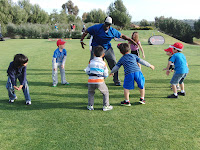Stepping up.
 |
| Coach Milo playing mirror games. |
There have been more than a few folks who have asked about
The Biggest Loser and the new “kids” addition to it. That sinking, pit-of-the-stomach, feeling socked me as soon as I heard they’d have kids on the
show.
The biggest problem with the show is that it's
on television, and commercial television is largely about one thing, making
$$$$$. Shows need ratings to make money. So they will do what they need to do
to get those ratings.
Sorry folks, the health of our future isn't a game show; it's not
about getting ratings.
 |
| No dodgeball? Yeah right! |
TBL is not reality. The only thing good about
that show is it's getting folks talking about fitness. But, even within the
fitness community, Jillian, the show's biggest star, is a one-trick-pony. "Let’s
tear ‘em down and build ‘em back up!!!" Berating and belittling go a long way toward creating tears,
angst and anger. That’s the perfect recipe for ratings. Jillian is a good-looking,
in shape marketing machine. She may be a great person - seriously. I wouldn't know because I don't know her. But the character she
plays on TBL stinks. In her first show back, she pushed five people until they
collapsed, and one quit. They had 5-mile walks. They, trainers, laughed at the effort. She kicked people out the gym, too. Give me a break. There are many who roll their eyes at me when I talk about fitness tasks. But if I were more like Jillian, would that be better? That's
not great training, not even close. Actually, that's pretty pathetic. But in
this country, if you're marketed right, you're the expert. Trainers throughout
the country have to fight that stigma all the time.
 |
| Coach Ivan: Flag football with the young athletes. |
I wish it were just my being jealous of a
trainer who is in the limelight and is making a grip off every show and every
product. But I'm confident and content yet still driven in my career path. This
just irritates me. Now they’ve taken it up a notch. Screwing with adults is one
thing. Many adults are psychologically and biologically prepared to
deal with the ramifications of TBL’s information. Our teens are not (that's
another thing, if the goal was to address our alarming childhood obesity rates,
why did they start teens. They should've started with even younger children).
 |
| What ever happened to free play? |
The first problem TBL has with the obesity
problem is premise that they believe they are going to raise awareness of
childhood obesity in the US. File
that one under, “Holy Self-Indulgent Bovine Excrement Batman!” Really? Does this
show believe that it has uncovered a secret or that the nation fails to see the problem we have with our
inactive, overweight and obese youth? Awareness isn’t the issue. It hasn’t been
for a long time. Proper action is the issue. Adults are acting too much on logic while dealing with
obesity – an emotional issue. We have to use emotion to deal with emotion.
 |
| Moms, sons, daughters. Nothing wrong with this picture! |
The second problem TBL has with the children is
they’re letting the regular trainers work with the kids. TBL, if it were
looking to actually create a positive change within the culture surrounding our
young folks and their health, could have gotten a person more adept at
interacting with kids. They should have found the biggest “kid” around to play with the three
that they chose. OH AND WHAT’S WITH ONLY THREE KIDS?!?! Seriously, there are
games you can play with three, but there are many more you can play with eight
to 10. And with eight to 10 kids, there is a higher chance that there will be a wider cross-section of the nation's obese young.
Instead TBL is using the same trainers who are
simply showing their softer side. But nobody is playing. Kids, even teenagers,
want to play. Hell, even when NFL Play 60 did its two pennies worth, the kids
still didn’t play! They cheered on the NFL Players hoping to get a player at
their school.
Really, I love the thought behind the NFL’s Play
60 campaign. They want to do good stuff. They want to – at least it appears –
be an agent for action with youth fitness. But the program falls well short of
what it could be.
 |
| Want kids moving? Adults have to move, too! |
Our kids are going to get the biggest loser's
message either directly by watching the show or indirectly by their parent's
friend's ex-father in-law who heard it from that part-time crossfit instructor
outside of Taco Bell. And the message they’re going to get is that it’s okay to tell
everybody the social problems you have so we can all feel sorry for you and shed
some tears.
It's sad. We understand. But it's not melodramatic and shouldn't be sensationalized.
We know the problem! We see it every damn day.
What the nation needs to see is how to solve the problem. Telling the teens to
try dancing and kickboxing? C’mon,
stop passing the buck! Get in there, and play games with the kids. Make them
feel as if they are an integral part of something that’s bigger than them.
Stepping down.
